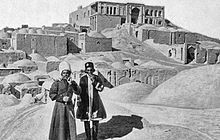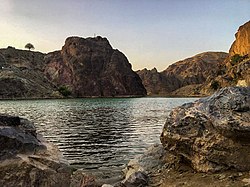world.wikisort.org - Iran
Birjand[2] (Persian: بیرجند ![]() pronunciation (help·info), also Romanized as Bīrjand and Birdjand)[3] is the capital of the Iranian province of South Khorasan. The city is known for its saffron, barberry, jujube, and handmade carpet exports.[4]
Birjand had a population of 187,020 in 2013.[5]
pronunciation (help·info), also Romanized as Bīrjand and Birdjand)[3] is the capital of the Iranian province of South Khorasan. The city is known for its saffron, barberry, jujube, and handmade carpet exports.[4]
Birjand had a population of 187,020 in 2013.[5]
Birjand | |
|---|---|
City | |
Birjand castle, Dande Barre, Shokatiyeh School, Veteran's Square | |
| Nicknames: City of Pines, City of Culture | |
 Birjand | |
| Coordinates: 32°52′N 59°13′E | |
| Country | Iran |
| Province | South Khorasan |
| County | Birjand |
| Bakhsh | Central |
| First mention | 13th century |
| Elevation | 1,491 m (4,892 ft) |
| Population (2016 census) | |
| • Density | 3,697/km2 (9,580/sq mi) |
| • Urban | 203,636 [1] |
| • Metro | 248,623 |
| Time zone | UTC+3:30 (IRST) |
| • Summer (DST) | UTC+4:30 (IDST) |
| Area code | (+98) 56 |
| Climate | BSk |
| Website | www.birjand.ir/ |
| Prefix code: +98 Iran – (0)56 Birjand | |
History

The first citation of the city in the historical literature belongs to the famous book Mojem Alboldan, by Yaqut Homavi (13th century) which introduces the Birjand as the most beautiful town in the Qohestan. Before this, Birjand had been probably not as big and important as a municipality but rather as a rural community. However, the Birjand geographical area had its historical and political importance long before the emergence of the city of Birjand. Many citations of the region are available in the original literature like Ehya -ol- Molook of the once important localities in the area. Apart from literature, the oldest evidence on the history of the region is the ancient Lakh-Mazar inscription in the Kooch village some 25 km (16 mi) southeast of Birjand. Numerous fine drawings and inscriptions are carved on an igneous rock surface. The inscriptions include pictograms as well as Arsacid Pahlavi, Sasanian Pahlavi, Arabic and Persian scripts.[6]
Climate
Birjand has a cold semi-arid climate (Köppen climate classification BSk) with hot summers and cool winters and a significant difference between day and night temperatures. Precipitation falls mostly in winter and spring.
| Climate data for Birjand (1955-2010) | |||||||||||||
|---|---|---|---|---|---|---|---|---|---|---|---|---|---|
| Month | Jan | Feb | Mar | Apr | May | Jun | Jul | Aug | Sep | Oct | Nov | Dec | Year |
| Record high °C (°F) | 25.0 (77.0) |
27.0 (80.6) |
32.0 (89.6) |
36.0 (96.8) |
40.6 (105.1) |
43.0 (109.4) |
44.0 (111.2) |
43.0 (109.4) |
40.0 (104.0) |
36.0 (96.8) |
29.0 (84.2) |
27.0 (80.6) |
44.0 (111.2) |
| Average high °C (°F) | 11.0 (51.8) |
13.5 (56.3) |
18.7 (65.7) |
24.8 (76.6) |
30.5 (86.9) |
35.0 (95.0) |
35.8 (96.4) |
34.5 (94.1) |
31.8 (89.2) |
26.6 (79.9) |
19.6 (67.3) |
13.6 (56.5) |
24.6 (76.3) |
| Daily mean °C (°F) | 4.3 (39.7) |
6.7 (44.1) |
11.6 (52.9) |
17.2 (63.0) |
22.2 (72.0) |
26.4 (79.5) |
27.8 (82.0) |
25.8 (78.4) |
22.0 (71.6) |
16.9 (62.4) |
10.9 (51.6) |
6.2 (43.2) |
16.5 (61.7) |
| Average low °C (°F) | −2.3 (27.9) |
-0 (32) |
4.5 (40.1) |
9.7 (49.5) |
13.8 (56.8) |
17.9 (64.2) |
19.8 (67.6) |
17.1 (62.8) |
12.3 (54.1) |
7.2 (45.0) |
2.2 (36.0) |
−1.1 (30.0) |
8.4 (47.2) |
| Record low °C (°F) | −21.5 (−6.7) |
−17.6 (0.3) |
−12 (10) |
−4.5 (23.9) |
0.0 (32.0) |
7.0 (44.6) |
10.2 (50.4) |
6.0 (42.8) |
1.0 (33.8) |
−5.6 (21.9) |
−11 (12) |
−15.8 (3.6) |
−21.5 (−6.7) |
| Average precipitation mm (inches) | 31.3 (1.23) |
32.4 (1.28) |
35.1 (1.38) |
31.6 (1.24) |
7.1 (0.28) |
0.3 (0.01) |
0.1 (0.00) |
0.2 (0.01) |
0.0 (0.0) |
2.6 (0.10) |
8.4 (0.33) |
19.7 (0.78) |
168.8 (6.64) |
| Average rainy days | 7.9 | 8.3 | 9.2 | 8.0 | 3.6 | 0.7 | 0.4 | 0.2 | 0.3 | 1.6 | 3.3 | 6.3 | 49.8 |
| Average snowy days | 2.6 | 1.7 | 0.3 | 0.2 | 0 | 0 | 0 | 0 | 0 | 0 | 0.1 | 1.1 | 6 |
| Average relative humidity (%) | 57 | 55 | 46 | 38 | 27 | 21 | 21 | 22 | 22 | 28 | 39 | 52 | 36 |
| Mean monthly sunshine hours | 196.3 | 188.3 | 211.4 | 231.8 | 303.4 | 334.8 | 347.2 | 349.3 | 298.2 | 286.0 | 229.6 | 195.8 | 3,172.1 |
| Source 1: NOAA (1961–1990)(precipitation, humidity, sunshine hours) [7] | |||||||||||||
| Source 2: (records, temperature normals) | |||||||||||||
official services
Municipality
In 1310, Birjand Municipality was opened under the name of Birjand Municipality next to the tomb of Hakim Nazari and started its activities with 12 employees. The first mayor of Birjand was Mr. Afshar, who served as mayor for six years.[8]
University
In 1975, following Dr. Mohammad Hassan Ganji, the Birjand Institute of Higher Education was established in the Assadollah Alam Endowment Collection. This university started with the admission of 120 students in the fields of mathematics, physics and chemistry and is now officially known as Birjand University.[9][10]
Airport
In 1312, due to the political and military situation of Birjand city and the east of the country, Birjand airport was established on a 150-hectare land in the north of the city.[11][12]
Customs
In 1317, in order to facilitate the transportation, export and import of goods to the subcontinent of India and Afghanistan, the Birjand Customs Office was established and started its activities with two customs units, Dareh and Gezik.[13]
Imam Reza Hospital
In 1327, Imam Reza Hospital was established in one of the lands and endowments belonging to the Alam family, known as Bagh-e Anari. In addition to accepting patients in Birjand city, this hospital also accepted other patients in southern cities of Khorasan province.[14]
Education
It is said that the Shokatiyeh School in Birjand together with Darolfonoon in Tehran were the first modern public schools of higher education in Iran in the mid-19th century. Ever since then, Birjand has amassed an abundance of institutions of higher education and become an important location for research and development.
The city contains such universities and academic institutions as:
- University of Birjand[15]
- Birjand University of Technology[16]
- Birjand University of Medical Sciences[17]
- Payame Noor University[18]
- Islamic Azad University of Birjand[19]
- University of Applied Science and Technology (south khorasan branch)
- Academy of Tarbiat-e Moalem
- Academy of Amuzesh-e Aly
- Academy of Amuzesh-e Modiriat Dolaty

Notable people
- Abd al-Ali al-Birjandi, 16th century astronomer
- Hakim Nezari Quhestani
- Ibn Hessam Khusfi
- Amir Shokat Ul-Molk Alam, Amir of Qaen County and Governor of Quhestan at the end of Qajar Dynasty
- Amir Ali Khan Sheibany, PhD, founder and first CEO of Zob Ahan Esfahan (Esfahan Steel Company)
- Seyyed Mohammad Tadayyon
- Asadollah Alam, prime minister of Iran during Pahlavi dynasty
- Seyyed Gholam Reza Saeidi, writer
- Mohamad Haghgou, composer
- Sima Bina, Iranian folk music singer
- Ahmad Kamyabi Mask, writer and renowned theater scholar
- Morteza Hassanpour, first Iranian male nurse
- Mohammad Hassan Ganji, geographer
- Mohammad Ismail Rezvani, historian
- Mohammad Reza Hafeznia
- Gholam Hossein Shokouei

- Kazem Motamadnejad
- Shah Seyyed Ali Kazemi, Last tribal leader in Moud and Birjand at the beginning of Pahlavi Dynasty
- Mohammad Hossain Ayati
- Mohammad Ibrahim Ayati
- Seyyed Hassan Tahami
- Ardalan Shoja Kaveh, actor
See also
References
- "Statistical Center of Iran > Home".
- Naghizadeh, Mohammad Sadegh; Naseri, Mohsen; Fereyduni, Mohammad; Ziaee, Masoud; Tane, Abdolghader; Safari, Hamidreza; Mahavar, Neda; Mahdavi, Roya; Anani Sarab, Gholamreza (2018-04-01). "Single Nucleotide Polymorphism of the Interferon-γ Gene (IFN-γ +874 T/A) and the Prognosis of Hepatitis B Infection". Journal of Medical Microbiology and Infectious Diseases. 6 (2): 43–47. doi:10.29252/jommid.6.2.3.43. ISSN 2345-5349.
- Birjand can be found at GEOnet Names Server, at this link, by opening the Advanced Search box, entering "-3056455" in the "Unique Feature Id" form, and clicking on "Search Database".
- "Cities in Iran: 2005 Population Estimates". Mongabay.com.
- "Archived copy". Archived from the original on 2007-12-11. Retrieved 2016-02-06.
{{cite web}}: CS1 maint: archived copy as title (link) - Research articles collection (archaeology, ancient inscriptions): Lakh-Mazar, Birjand. Rajab Ali Labbaf Khaniki, Rassul Bashash Kanzaq. 25. Iranian Cultural Heritage Organization. Summer 1994.
- "Birjand Climate Normals 1961–1990". National Oceanic and Atmospheric Administration. Retrieved December 29, 2012.
- "New Page 1". 2008-11-21. Archived from the original on 21 November 2008. Retrieved 2022-01-28.
- "University of Birjand". University of Birjand. Retrieved 2022-01-31.
- https://web.archive.org/web/20080410225020/http://www.birjand.ac.ir/about.aspx. Archived from the original on 10 April 2008. Retrieved 2022-01-28.
{{cite web}}: Missing or empty|title=(help) - Flightradar24. "Live Flight Tracker - Real-Time Flight Tracker Map". Flightradar24. Retrieved 2022-01-31.
- "فرودگاهها". 2008-03-02. Archived from the original on 2 March 2008. Retrieved 2022-01-24.
- "برخى از گياهان داروئى شهرستان بيرجند و خواص درمانى آنها". 2008-11-21. Archived from the original on 21 November 2008. Retrieved 2022-01-24.
- "New Page 1". 2008-11-21. Archived from the original on 21 November 2008. Retrieved 2022-01-24.
- "دانشگاه بیرجند - نگین آموزش عالی شرق کشور".
- "دانشگاه صنعتی بیرجند | تنها دانشگاه صنعتی شرق کشور".
- "دانشگاه علوم پزشکی بیرجند".
- "سامانه خدمت دانشگاه پیام نور استان خراسان جنوبی". www.skpnu.ac.ir. Retrieved 10 April 2018.
- "Islamic Azad University of Birjand (MMD)". Archived from the original on 2006-08-24. Retrieved 2006-07-28.
External links
На других языках
[de] Birdschand
Birdschand (persisch بيرجند Birdjand, ‚Sturmstadt‘) ist die Hauptstadt der iranischen Provinz Süd-Chorasan (ehemals Subprovinz Birdschand) mit seinen 179.686 Einwohner (Stand: 2012), einer Landfläche von 88.404 km² (März 2004) und einer Einwohnerdichte von 7 Einwohner je km².- [en] Birjand
[ru] Бирдженд
Бирдже́нд (перс. بيرجند) — город на востоке Ирана, административный центр провинции Южный Хорасан.Другой контент может иметь иную лицензию. Перед использованием материалов сайта WikiSort.org внимательно изучите правила лицензирования конкретных элементов наполнения сайта.
WikiSort.org - проект по пересортировке и дополнению контента Википедии






